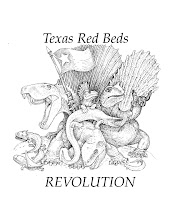 Dr. Robert T. Bakker is the leader of the handful of iconoclastic paleontologists who rewrote the book on dinosaurs three decades ago. Along with other noted paleontologists such as John Ostrom and Armand de Ricqules, Bakker has changed the image of dinosaurs from slow-moving, slow-witted, cold-blooded creatures to, in at least some cases, warm-blooded giants well equipped to dominate the Earth for 200 million years. Long before feathered fossils were found, Bakker contended that some dinosaurs were endowed with insulating feathers. New research continues to lend strong support to this view, no longer in the minority.
Dr. Robert T. Bakker is the leader of the handful of iconoclastic paleontologists who rewrote the book on dinosaurs three decades ago. Along with other noted paleontologists such as John Ostrom and Armand de Ricqules, Bakker has changed the image of dinosaurs from slow-moving, slow-witted, cold-blooded creatures to, in at least some cases, warm-blooded giants well equipped to dominate the Earth for 200 million years. Long before feathered fossils were found, Bakker contended that some dinosaurs were endowed with insulating feathers. New research continues to lend strong support to this view, no longer in the minority.“I was fond of saying most of dinosaur science was wrong stuff, and that did offend a lot of people. Someone had to say dinosaurs had feathers,” said Bakker. “I want to put dinosaurs in context and in their chosen environment. I want you to be able to feel and think and smell what a Stegosaurus experienced. I want you to smell fresh fish on your teeth as a Ceratosaurus, then do this with the whole history of dinosaurs. Then I want you to finally understand how and why dinosaurs ruled.”
As curator of paleontology for the Houston Museum of Natural Science, Dr. Bakker has led the paleontology dig team in Seymour for the past two dig seasons, using a "CSI"-based approach, (for example, fossilized teeth uncovered are the “bullets” that help the team identify the victims and the predators in an ancient ecosystem) in order to discover the relationships between and the behavior of the species that lived in North Texas 250 million years ago.
In addition to his work with the Houston Museum of Natural Science, Dr. Bakker is also the Director of the Morrison Natural History Museum in Colorado. He is also the author of many books on paleontology, including the groundbreaking 1986 book The Dinosaur Heresies: New Theories Unlocking the Mystery of the Dinosaurs and Their Extinction. Bakker was among the advisors for the film Jurassic Park, and the character Dr. Robert Burke in the motion picture The Lost World: Jurassic Park is based on him.
